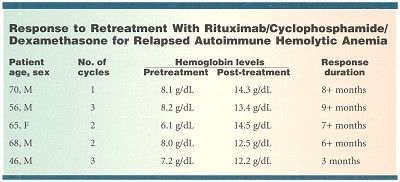Rituximab Combo Is Effective for Relapsed CLL-Associated Autoimmune Hemolytic Anemia
ORLANDO-Patients with chronic lymphocytic leukemia (CLL) complicated by autoimmune hemolytic anemia (AIHA) usually improve following treatment with high-dose steroids but have few options if such treatment fails.
ORLANDOPatients with chronic lymphocytic leukemia (CLL) complicated by autoimmune hemolytic anemia (AIHA) usually improve following treatment with high-dose steroids but have few options if such treatment fails.
In a poster presented at the 43rd Annual Meeting of the American Society of Hematology (abstract 1529), Kanti R. Rai, MD, reported long-term follow-up data on eight such patients suggesting that a rituximab (Rituxan), cyclophosphamide, dexamethasone combination regimen is effective not only as initial salvage therapy in such patients but also as retreatment for relapse.
Dr. Rai said that up to 30% of CLL patients with AIHA either do not respond to conventional steroid regimens or relapse and have a poor response to steroid retreatment.
Coombs positivity and AIHA are both well-recognized complications of CLL, Dr. Rai said. AIHA arises as a consequence of the destruction of red blood cells mediated by autoreactive antibodies. The means by which these autoreactive antibodies arise is as yet unknown, but it is postulated that the imbalance of lymphocyte subsets in CLL patients leads to this complication.
Corticosteroids and intravenous immunoglobulin are the standard treatment for AIHA. Rituximab is active in CLL, Dr. Rai said, "so using rituximab in a patient with CLL complicated by AIHA could have two potential benefits by eradicating the neoplastic CLL cells as well as achieving control of AIHA."
Based on that assumption, Dr. Rai, Niraj Gupta, MD, and their colleagues at Long Island Jewish Medical Center, New Hyde Park, New York, studied rituximab, cyclophosphamide, and dexamethasone in eight CLL patients with AIHA refractory to steroids, intravenous gamma-globulin, or immunosuppressants.
Patients were given rituximab 375 mg/m2 IV on day 1; cyclophosphamide 750 to 1,000 mg/m² IV on day 2; and dexamethasone 12 mg/d IV on days 1 and 2 and orally on days 3 to 7. Cycles were repeated monthly. Blood products were given only to patients with symptomatic anemia or thrombocytopenia.
The researchers reported last year that all eight patients had an excellent response to this regimen. Hemoglobin levels improved from a pretreatment median of 8.3 g/dL to 13.5 g/dL, and Coombs test converted to negative in five patients after initial treatment. Duration of initial response was 13 months, ranging from 7 to more than 23 months.
Five of the eight patients subsequently relapsed, and in this poster Dr. Rai reported that all five responded to retreatment with the rituximab combination (see Table). Hemoglobin improved from a pretreatment median of 8 g/dL to a post-treatment median of 13.4 g/dL. One patient became Coombs negative after retreatment. "All 5 patients remain in response after a median of over 7 months," Dr. Rai said.

Toxicity included grade 4 neutropenia in one patient, but most of the side effects were related to the first rituximab infusion. No dose modifications were required, and no opportunistic infections were observed.
The second remissions of AIHA followed a median of two cycles of the combination therapy. Dr. Rai said that the improvement in hemoglobin was evident after the first cycle. Median duration of response to retreatment is 7+ months (range, 3 to 9+ months). One patient had a second relapse after 3 months and died 3 months later of progressive CLL.
Dr. Rai also provided follow-up on the three patients of the original eight who were not retreated: Two of these continue in remission at 22+ and 23+ months, and one died of progressive CLL 16 months after the initial response to the combination therapy.
These results demonstrate that this regimen is highly effective in controlling AIHA of CLL in patients who relapsed after an initial response achieved earlier with the same regimen, he said.
"Such a high success rate was not possible to achieve with any of the previously used therapies for recurrent AIHA of CLL. Only two cycles were required to achieve the maximum response on retreatment, the toxicity profile is acceptable, and we think that rituximab deserves exploration in the treatment of this and other autoimmune hematological disorders," Dr. Rai said.
"There has been a trend recently to give rituximab either in very high doses weekly or more often than once a week. However, these findings clearly indicate that the standard 375 mg/m² dose is quite effective when given as infrequently as once a month when combined with other agents such as cyclophosphamide and dexamethasone," Dr. Rai concluded.